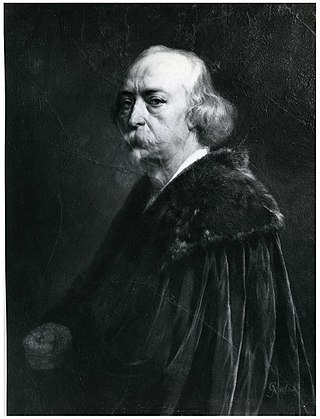
Giacomo Grosso (23 May 1860 in Cambiano - 14 January 1938 in Turin) was an Italian painter.
Contents


Giacomo Grosso (23 May 1860 in Cambiano - 14 January 1938 in Turin) was an Italian painter.

After spending his childhood at Glaveno seminary, Giacomo Grosso enrolled at the Accademia Albertina in Turin in 1873, thanks to a scholarship he was awarded by Cambiano Town Council. He became a pupil of Andrea Gastaldi and made his debut in 1882 at the 24th Esposizione della Società di Incoraggiamento alle Belle Arti di Torino, completing his studies the following year. In 1884, he participated in the Esposizione Generale Italiana in Turin with a painting inspired by La storia di una capinera by Giovanni Verga. After coming into contact with the Paris art scene through his many stays in the French capital, he continued to exhibit assiduously in the Turin Promotrici, the Venice Biennale from the first edition in 1895 (with a one-man show in 1912), and in other international shows (Paris, 1896; Munich, 1899; San Francisco, 1915) where he became acclaimed as a portraitist. From 1901 when he made his first journey to South America he began to receive commissions from Argentina and in 1910, for the celebration of the Argentinean Centennial in Buenos Aires, he executed a large commemorative canvas The panorama of the Battle of Maipú (lost in the fire in 1923), an episode in the War of Independence. [1] From 1906 he held the chair of painting at the Accademia Albertina in Turin and in 1929 he was nominated senator of the Kingdom of Italy. His solo exhibition of over fifty works was curated by Leonardo Bistolfi at the Galleria Pesaro, Milan, in 1926.
Among his pupils are Arturo Conterno, [2] Maurizio Pellegrini, [3] Eso Pelluzi, [4] and Giovanni Rava. [5]
Cesare Ferro Milone, sometimes known only as Cesare Ferro, was an Italian painter born in Turin.

Giovanni Fattori was an Italian artist, one of the leaders of the group known as the Macchiaioli. He was initially a painter of historical themes and military subjects. In his middle years, inspired by the Barbizon school, he became one of the leading Italian plein-airists, painting landscapes, rural scenes, and scenes of military life. After 1884, he devoted much energy to etching.

Enrico Gamba was an Italian painter of genre scenes, period pieces and a few portraits.

Giuseppe Pellizza da Volpedo was an Italian Divisionist painter. Pellizza was a pupil of Pio Sanquirico. He used a Divisionist technique in which a painting is created by juxtaposing small dots of paint according to a specific colour theory. Although he exhibited often, his work achieved popularity in death through their reproduction in socialist magazines and the acclaim they received from 20th-century art critics.

Francesco Menzio was an Italian painter.

Paolo Gaidano (1861–1916) was an Italian painter, born in Poirino, in the region of the Piedmont.

Giacomo Gandi was an Italian painter noted for genre painting.

Bartolomeo Giuliano was an Italian painter; primarily of portraits and genre scenes.
Eso Peluzzi was an Italian pointillist painter. He was the uncle of contemporary painter Claudius Bonichi.
Maurizio Pellegrini was an Italian painter and lawyer.

Andrea Gastaldi was an Italian painter, primarily of historical canvases and portraits.
Giuseppe Riccardo "Beppe" Devalle was an Italian painter and collagist, acknowledged as one of the most interesting and highly appreciated artists of the last few decades of Italian painting. He always refuted the prevailing trends of the day so as to create and distinguish his own individual style: this may explain why Devalle has often been overlooked and placed as something of an outsider. He has been known as a master of photomontage and defined as a creator of the 'New Epic Italian style'.
Domenico Buratti was an Italian painter, poet and illustrator.

Vittorio Cavalleri or Cavalieri was an Italian painter. He mainly painted outdoor genre scenes.

For the Italian artist born in 1942, see Piero Gilardi.
Luigi Maria Giorgio Chessa (1898–1935) was an Italian painter, architect, scenic designer, and potter.
Arturo Conterno was an Italian painter, active mainly in Turin.

Giovanni Rava was an Italian painter, active mainly in Turin.
Giovanni Guarlotti was an Italian painter, active mainly in Turin.
Daphne Mabel Maugham later Daphne Maugham-Casorati (1897–1982) was a British painter, who emigrated to Turin, Italy.
![]() Media related to Giacomo Grosso at Wikimedia Commons
Media related to Giacomo Grosso at Wikimedia Commons